All the Answers
Well-known member
Federal University March: chronicle of a mobilization of students to defend public education - Infobae

Source:
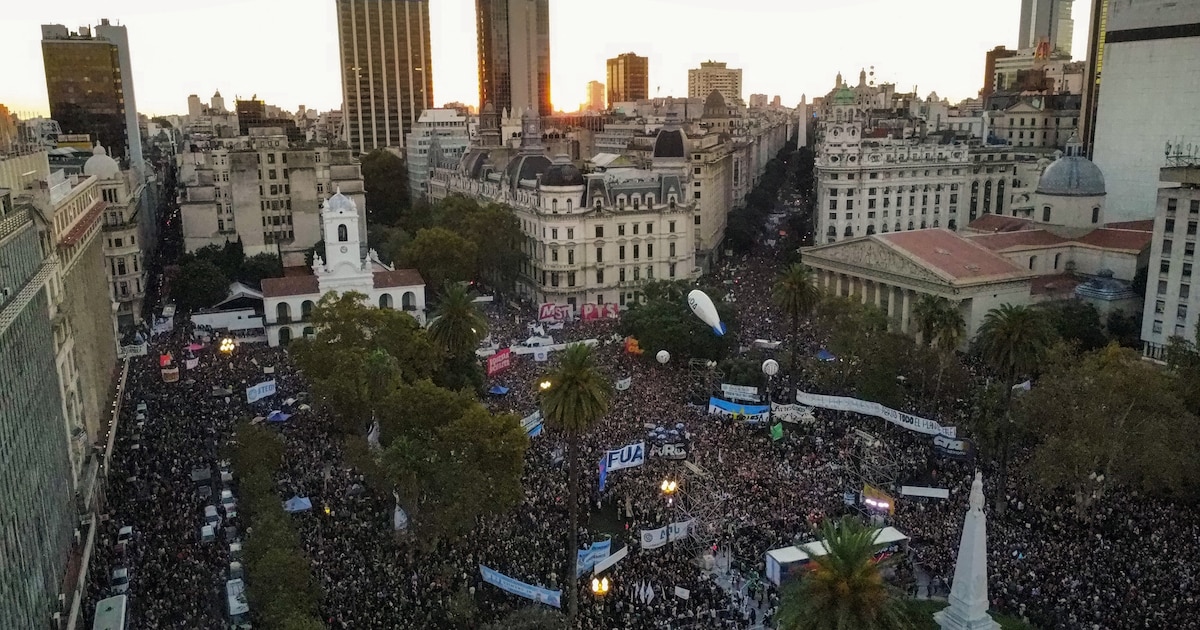
Marcha Universitaria Federal: crónica de una movilización de estudiantes para defender la educación pública
La manifestación colmó la Plaza de Mayo y varias cuadras alrededor. Hubo fuerte presencia de alumnos, pero también movilizaron opositores y gremios. Hubo fuertes críticas al ajuste en las universidades nacionales
April 23, 2024
The demonstration filled the Plaza de Mayo and several surrounding blocks. There was a strong presence of students, but opponents and unions also mobilized. There was strong criticism of the adjustment in national universities
By Robertino Sánchez Flecha
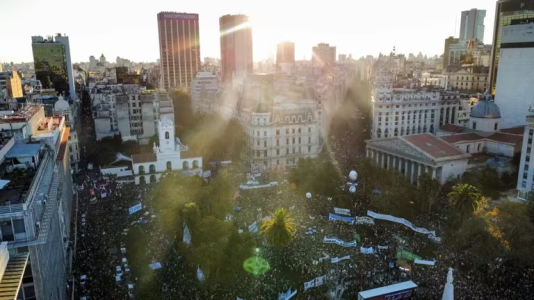
Federal University March: chronicle of a mobilization of students to defend public education (REUTERS/Agustin Marcarian)
The Federal University March eclipsed the information and political agenda. The claim for the lack of resources for the 36 national universities raised eyebrows and shook the Government of Javier Milei. It was a massive mobilization, of nearly 800,000 people - according to calculations by the University of Buenos Aires - that achieved transversality and united multiple sectors of the university system, unionism, civil society and the political opposition behind a slogan that is difficult to challenge: “ In defense of the public university.”
The etiology of the claim was caused by the decision of the Executive Branch to extend the 2023 Budget. With inflation that is around 270% year-on-year, and that accumulates close to 60% in the first quarter of 2024, the funds for public universities were liquidated . The authorities of the most prestigious study houses in the country started a dispute against Balcarce 50 to demand an update of the games. However, Milei adopted a confrontational stance and avoided giving in. That attitude gave space to germinate the massive march that this afternoon collapsed the Plaza de Mayo.
Before noon, the first students, teachers and self-convened people began to gather in Plaza Houssay . It is the heart of a university neighborhood, where the faculties of Medicine, Economics and Pharmacy and Biochemistry of the University of Buenos Aires (UBA) coexist, the study house that drives the claim for the lack of budget for the 36 national universities. The majority of the UBA world converges in that area, from where they began to walk to Congress. The Federal University March, as this demand was named, deployed the most convening mobilization with demands against the government of Javier Milei.
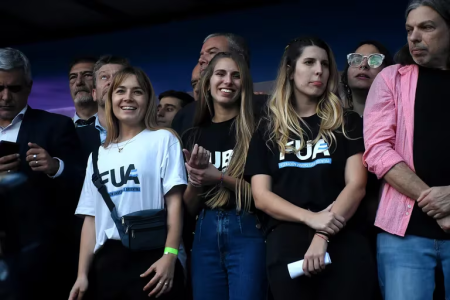
Piera Fernández de Piccoli, president of the Argentine University Federation (FUA), and Lucille Levy, president of the Buenos Aires University Federation (FUBA), on the central stage of the event (Nicolas Stulberg)
The central column that started from Plaza Houssay advanced from 3pm in the direction of Congress. Ricardo Gelpi , rector of the University of Buenos Aires, Emiliano Yacobitti , vice-rector, Piera Fernández de Piccoli , president of the Argentine University Federation (FUA), and Lucille Levy , president of the University Federation of Buenos Aires (FUBA), headed that sector of mobilization. “It is the most important student march in history,” Yacobitti highlighted in statements to the press.
Minutes before 6 p.m., the central event began from the Plaza de Mayo. First the stanzas of the National Anthem sounded. Then a round of speakers began. The one who broke the silence was Taty Almeida , head of Mothers of Plaza de Mayo Founding Line. “We are here to repudiate President Milei's decision of not wanting to subsidize public universities and public schools,” said the representative of the Human Rights movements. “The President criticized that it is a political march and of course it is, but it is not partisan ,” Almeida clarified.
Then it was the turn of Adolfo Pérez Esquivel , Nobel Peace Prize winner, who wished “a lot of strength” to the university students who marched. “We defend the public, free and free university, which is a great achievement of our people that we are not going to give up ,” emphasized the social leader.
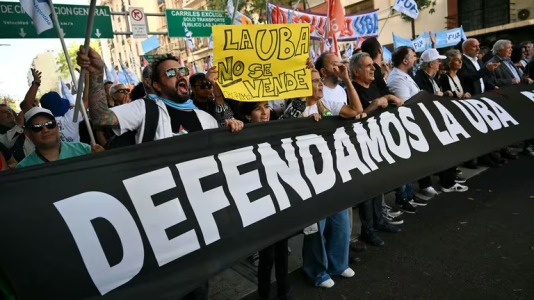
The federal university march will take place throughout the country
On stage there were rectors of different national universities, teaching and non-teaching workers, as well as students and leaders of the student movements. The presence of Gelpi and Yacobitti , from the UBA, Carlos de Feo , head of the National Federation of University Teachers (CONADU), Sonia Alesso , head of CETERA, Sergio Romero , from the UDA, Norberto Heyaca, general secretary of the Association stood out. UTN Teachers' Union, Oscar Vallejos , deputy secretary of the Historical CONADU, Walter Merkis, head of the Argentine Federation of Workers of National Universities. Piera Fernández and Lucille Levy were also there.
After the speeches of the leaders of the higher education unions, it was time to read the final statement of the march. It was an extensive document with a strong message against the national government: “ The public university is going through a critical period as a consequence of the policies implemented by the national government ,” was the title of the text agreed upon by the authorities, referents and rectors of the university system. .
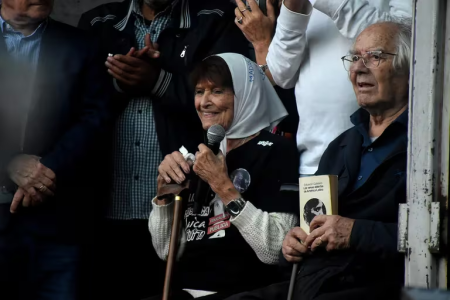
Taty Almeida, leader of Mothers of Plaza de Mayo Línea Foundadora, and Adolfo Pérez Esquivel, Nobel Peace Prize winner, on the stage of the University March
Among the most resonant points, the statement expressed that public universities “are one of the engines of democracy” and questioned the “strong adjustment in real terms” in the so-called operating expenses.” He then classified as “ absolutely insufficient” the Government's recent announcement regarding the 70% increase in the university budget in March and May.
“We demand free joint ventures, without ceilings, to guarantee commensurate salaries, and that the FONID be immediately restored ,” requested the organizers of the march. Furthermore, they rejected the “ policy of adjustment and discipline . ” Meanwhile, they pointed out: “We do not want our dreams to be taken away from us: our future does not belong to them .” “A country that does not invest in science, renounces its sovereignty .”
The complete statement of the Federal University March
A march, a claim, multiple people
The march had started shortly after 3:00 p.m. Around 3:30 p.m., the different columns gathered in the Plaza del Congreso. There had been the concentration point of picketing groups such as the Polo Obrero, led by Eduardo Belliboni , and the UTEP, leaders and militants of the left. The presence of Myriam Bregman , national representative, Christian Castillo , national representative of the PTS, and Gabriel Solano , Buenos Aires legislator of the FIT, stood out.However, the political leaders present sought to remain in the third ranks and not overshadow the organizers. “The public university is something strategic for Argentina and there is no reason for the closure and for making this cut in the universities. Only today did the Government send the first funds for the university hospitals. A separate chapter for university salaries, which lost 36% of purchasing power in December ,” Yacobitti noted in another section.
There are banners and flags with multiple slogans, united in a general claim: “ In defense of the public university .” From Avenida Córdoba and then along Avenida Callao, the central column of the universities advances. The long arm of those summoned will converge at Congress, from where they will march towards the Plaza de Mayo. The central stage was set up in that historical landmark of the City of Buenos Aires.
Sergio Massa, leader of the Frente Renovador, reappeared in the march with his wife, the leader Malena Galmarini, and their children
The stage was set up in the middle of the square, with an Argentine flag in the background with the same motto: “In defense of the public university.” As Infobae learned , the event will begin at 6 p.m. and it is expected that only representatives from national universities will be on stage. “ There is not going to be any politician at the top ,” a UBA official told this medium.
From there, the organizers will read a statement that was agreed upon by rectors, university authorities, students, teachers and non-teachers. “The focus of the text is to demand more budget for the university, because we cannot continue functioning like this,” explained a representative of the student movement who participated in the preparation of the document.
The text is expected to be read by Piera Fernández de Piccoli , president of the Argentine University Federation (FUA) , which brings together the university's student movement. Lucille Levy, president of the University Federation of Buenos Aires (FUBA), will also be on stage . Ricardo Gelpi, rector of the UBA, and Emiliano Yacobitti, vice-rector, will also join.
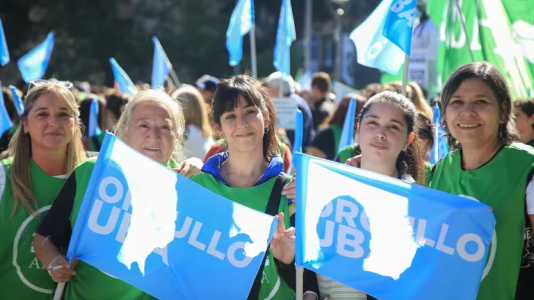
A group of UBA students in the University March
To guarantee public order, Patricia Bullrich 's Ministry of Security deployed the four federal forces. The Argentine Federal Police, the National Gendarmerie, the Argentine Naval Prefecture, and the Airport Security Police intervened in the National Congress area. The security protocol was coordinated with the City of Buenos Aires, executed by Waldo Wolff , Buenos Aires Minister of Security. The official instructed the local police to guard the route of the mobilization where there was no presence of federal forces. From the national universities they had assured that “the march will be peaceful” and asked “ not to repress .”
A march that united the opposition
Although today's march mobilized sectors of different political parties and unionism, the organizers demanded not to use party posters . They asked to carry Argentine flags to symbolically unify the claim.During the previous days, the university call took on a greater aspect when the CGT announced its accession . Then the two CTA and other aspects of unionism folded. The political leaders of the opposition later did the same.
From politics, Kirchnerism mobilized both front-line leaders and militants linked to university militancy. Axel Kicillof , Buenos Aires governor, joined the march along with part of his cabinet cast. “This is part of the history of many of us, that is why we must defend the public university ,” said the president of Buenos Aires in television statements and added: “The number of people there is impressive, it is an entire town.”
Along with Kicillof were Verónica Magario , vice-governor of the province, and Buenos Aires officials such as Carlos Bianco , chief of staff, and Andrés Cuervo Larroque , minister of Community Development.
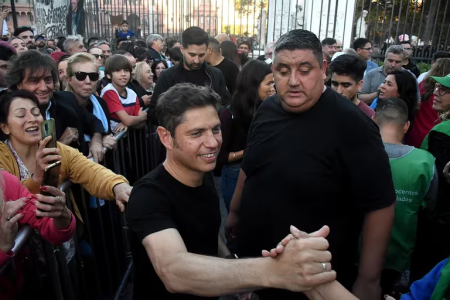
Axel Kicillof, governor of the province of Buenos Aires, present at the march (Nicolas Stulberg)
While the Renewal Front did the same. Sergio Massa , leader of that force, asked through WhatsApp groups of his brand to mobilize today and personally went to the Plaza de Mayo with his son, Tomás Massa, and his wife, the leader. Malena Galmarini . “I came to accompany my children and their colleagues,” said the former Minister of Economy when asked by an A24 reporter . The leader chose to keep a low profile and did not give any further statements. His presence stood out as a public reappearance at a massive event, after the 2023 elections.
Who also followed the march closely was Cristina Fernández de Kirchner , former president of the Nation. Although she did not participate in the march, she published on her X account her student certificate from the National University of La Plata and that of Néstor Kirchner, its former president. “Public education for equal opportunities,” wrote CFK and recalled milestones of her management in educational matters. Later, she came out to greet militants who were mobilizing Plaza de Mayo from a balcony of the Instituto Patria.
On behalf of Union for the Fatherland also mobilized leaders such as Wado De Pedro , Leandro Santoro, Mariano Recalde, Paula Penacca. There were mayors of the conurban, among whom was seen Fernando Gray , of Esteban Echeverria, Fernando Espinoza , of La Matanza, Fernando Moreira, of San Martin, Jorge Ferraresi , of Avellaneda.
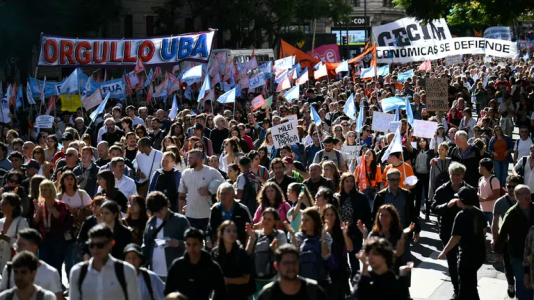
The organizers of the march will read a statement from the Plaza de Mayo to demand more funds
While the Radical Civic Union mobilized national deputies and senators, leaders, militants and co-religionist students linked to university groups such as the Purple Strip . “University and public education are what made us as a society. As a middle class society, with social advancement , which differentiated us from the rest of other countries that had a hard time reaching the university level that Argentina has today. And that today is at risk because the President attacks the university,” said Martín Lousteau , national senator of radicalism and president of the National Committee of the UCR.
The representative and national deputy Facundo Manes , the legislators Carla Carrizo, Pablo Juliano, Danya Tavela and the parliamentary secretary Alejandro Cacace were also mobilized on behalf of that party . “Today we could not stay locked in Congress. "I am the first graduate of a public university in my family, I couldn't not be at the march defending everyone's education," the neurologist said before the press.
On behalf of the Civic Coalition , Elisa Carrió's party, a group of leaders mobilized such as national deputies Maximiliano Ferraro , president of the label, Juan Manuel López and Maricel Etchecoin , as well as Hernán Reyes , Buenos Aires legislator.
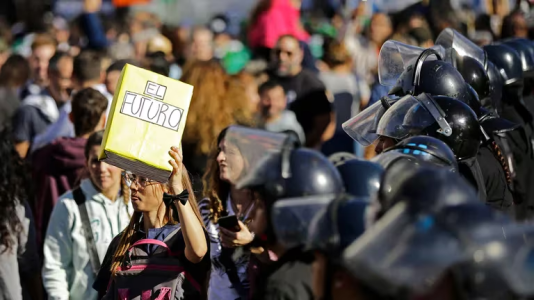
Federal University March to Plaza de Mayo (Photo by Emiliano Lasalvia / AFP)
Trade unionism also had a strong presence. Héctor Daer (Health), Pablo Moyano (Truckers), Andrés Rodríguez (UPCN), Gerardo Martínez (UOCRA) participated on behalf of the CGT . While there were also representatives of the two CTA, such as Hugo Yasky , and of the Autonomous CTA, Hugo Cachorro Godoy , its general secretary. The union arm was significant, given that it was the first time since Cordobazo that the student movement did not share a march with union leaders.
Complaints about lack of budget
The crisis of the university system was unleashed by the claim led by the UBA for the lack of budget that affects the operation of the largest university in the country and the rest of the national universities.The conflict was unleashed by the decision to extend the 2023 Budget, which was liquidated by high inflation. The Government announced on Thursday a “proposal agreed upon with the National Interuniversity Council ” regarding the budgetary situation of public universities. The decision of the Ministry of Human Capital, headed by Sandra Pettovello , who has the Secretary of Education of Carlos Torrondell under her orbit , ordered a 70% increase in March, bringing the allocation for operating expenses to $10,075,851,995 per month for the National Universities.
While it announced another 70% in May, reaching $14,224,732,213 per month, totaling a 140% increase over the base allocation of $5,926,971,777 per month. In addition, the measure allocated an extraordinary amount for the needs of university hospitals for a sum of $14,403,479,661 . The UBA came out to deny the agreement and indicated that the measure was “ insufficient .”


